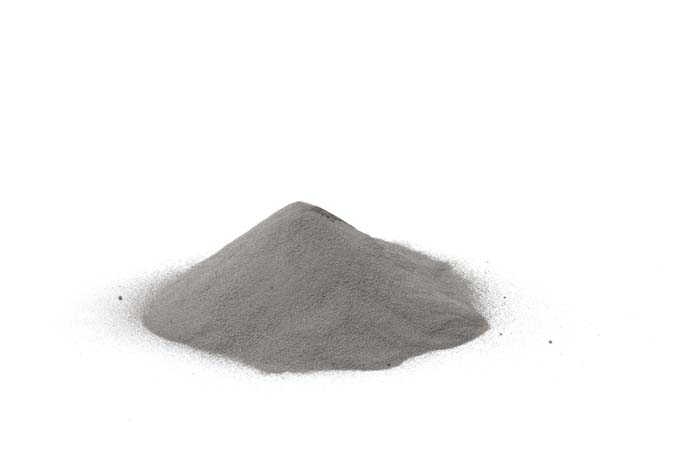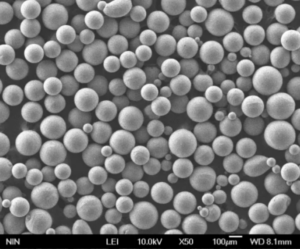Tungsten powders are used as consumables in industries such as 3D printing of tungsten and tungsten alloys, porous materials, and highly dense powder coating. This paper focuses on the preparation, applications, and prospects of tungsten powders.
Preparation of Spherical Tungsten Powder
With the rapid development of 3D printing technology, porous materials, highly dense powder coating, and injection molding, the demand for high-quality spherical tungsten powders is increasing.
High-quality spherical tungsten powder is not only good flowability, good sphericity, high apparent density and vibrational density, and low oxygen content.
The high price of high-quality spherical tungsten powders on the market has hindered the further development of 3D printing technology for tungsten products with complex structures. The advent of plasma spheroidisation of tungsten powders has alleviated this phenomenon.
Plasma, with its high temperature, high enthalpy, and high chemical reactivity, meets the demand for a heat source for tungsten powder spheroidisation in the tungsten powder spheroidisation process. Plasma spheroidisation technology involves the spraying of irregularly shaped particles by a carrier gas through a charging gun into a plasma arc. Under the action of heat transfer mechanisms such as radiation, convection, and conduction, the powder is rapidly heated to whole or partial melting, and the molten particles rapidly solidify and shrink under surface tension to form a dense spherical powder. The advantages of plasma spheroidised tungsten powder are the high concentration of energy, the large temperature gradient, the ability to precisely control the energy input by controlling the process parameters, and the thermal energy utilization of up to 75%. After plasma spheroidisation, the fluidity of the tungsten is improved and the apparent density and vibrational density of the tungsten powder are increased.

The Application of Tungsten Powder
Compared to powder metallurgy, 3D printed tungsten parts not only have a wider variety of shapes but also higher overall properties such as shielding and high-temperature resistance, which makes them more versatile. 3D printed tungsten has the following main applications.
1) Manufacture of medical collimators. Compared to lead metal, tungsten alloy is more suitable for the production of collimators, not only because the alloy is environmentally friendly and non-toxic, but also because it has a strong ability to protect against radiation rays. Collimators are the component parts of the radiation head of medical accelerators, mainly used in oncological radiotherapy.
2) Manufacture of nozzles. Compared to ordinary brass or steel nozzles, tungsten alloy nozzles have better thermomechanical properties, mainly in terms of good heat resistance, good thermal conductivity, rigidity, high-temperature strength, and less susceptibility to extreme tempering.
3) Manufacture of components for x-ray scanning equipment. The high density gives tungsten alloys extremely good radiation protection, while the higher melting point and lower coefficient of volume expansion also give them a greater range of applications for use in high-temperature environments.
4) Manufacture of screws. With its high specific gravity, low-temperature resistance, and corrosion resistance, tungsten screws are widely used in counterweight parts for golf heads, parts for revival trainsets, and aerospace equipment.
5) Manufacture of heat insulation screens. It is suitable for application in vacuum resistance furnaces because of its good heat insulation effect, good corrosion resistance, strong ability to absorb radiation lines, excellent high-temperature resistance, and strong oxidation resistance.
(6) Manufacture of tungsten anti-scattering grids. 3D printed tungsten anti-scattering grids are suitable for use in CT scanners, an important weapon in the fight against new coronaviruses, due to their high-temperature resistance, wear-resistance and strong radiation resistance.
In addition to the tungsten parts mentioned above, 3D printing technology can also be used to produce products such as tungsten pins, contacts, die-casting molds, and heat generators.

The Prospects of Spherical Tungsten Powder in 3D Printing
As the most important consumable for 3D printed tungsten products, spherical tungsten powder has It has replaced conventional tungsten powder with its unique advantages. The preparation of spherical powder by halogenation and tungsten powder reoxidation reduction methods has various drawbacks such as low spheronization rate, low yield, and waste liquid disposal. The microwave single cavity method of spheroidizing tungsten powder has a low spheroidization rate, a low yield, and the need to dispose of the waste solution. The microwave single cavity method of spheroidizing tungsten powder has an insufficient heat source, and the performance of the tungsten powder produced is unstable and the consistency is poor.
At present, the spherical tungsten powder prepared in China still suffers from a wide particle size distribution, low yield, poor uniformity, and a high degree of stability. The research and development of spherical tungsten powder are still in the development stage. The research and development of spherical tungsten powder is still in the development stage, and the preparation process, technology, and procedure still need to be further studied.
The research and development of spherical tungsten powder are still in the development stage, and the preparation process, technology, and procedure still need to be further studied. The plasma spheroidization technology is characterized by high energy consumption, gas consumption high energy consumption, gas consumption, large investment in equipment, high operating costs, immature technology development, and other problems. However, the high energy of the plasma and the controllable reaction atmosphere allows for the preparation of other The plasma spheroidisation technique has problems of energy consumption, equipment investment, high operating costs, and mature technology development. The spherical tungsten powder produced by the plasma has a high sphericality. The prepared spherical tungsten powder has good sphericity, uniform particle size distribution, high densities and good fluidity. The whole preparation process is fast and continuous. Therefore, plasma spheroidization will be an alternative for the preparation of spherical tungsten powder. Therefore, plasma spheroidization is an alternative for the preparation of spherical tungsten powder. In combination with numerical simulations, the process parameters can be optimized quickly by combining numerical simulations. With the continuous improvement of plasma spheroidisation technology, the reduction of production costs, and the rapid optimization of the process parameters, plasma spheroidisation can be used to produce tungsten powder.
With the continuous improvement of plasma spheronization technology, the reduction of production cost, and the increase of powder yield, plasma spheronization technology will play an important role in the production of tungsten powder. The plasma spheroidisation technology will have a bright future in the industrial production of tungsten powder periodization.
Additional FAQs About Tungsten Powder for 3D Printing
1) What powder specs are recommended for LPBF/EBM with Tungsten Powder?
- Sphericity >0.95, PSD D10–D90 ≈ 15–45 µm (LPBF) or 45–90 µm (EBM), oxygen ≤0.08–0.12 wt%, moisture <0.02%, low satellites, apparent density ≥9 g/cm³. These improve flow, packing, and reduce lack‑of‑fusion and cracking.
2) How does Tungsten Powder behave during sintering and HIP?
- Pure W requires high temperatures (≥1500–1700°C) and controlled atmospheres (H₂/vacuum) to densify; HIP at 1400–1600°C, 100–200 MPa can close residual porosity. Grain growth control is critical to maintain strength.
3) What are practical design rules for printing tungsten parts?
- Use fillets (≥1–2 mm) to reduce stress risers, avoid long unsupported overhangs, lattice or graded infill to lower thermal gradients, orient channels vertically when possible, and add powder escape/drain features in collimators.
4) Is binder jetting viable for complex tungsten geometries?
- Yes. Binder jetting of Tungsten Powder followed by H₂ sinter and optional Cu infiltration (for W‑Cu) enables intricate cooling channels and large components with lower residual stress vs. LPBF.
5) How should Tungsten Powder be stored and reused?
- Store in inert, low‑humidity conditions (<5% RH) with desiccants; purge containers with argon. Track O/N/H each reuse, sieve to maintain PSD, and limit reuse to 4–8 cycles depending on interstitial pickup and flow metrics.
2025 Industry Trends for Tungsten Powder in Additive Manufacturing
- High-preheat builds: EBM preheats at 800–1000°C and induction‑heated LPBF plates (200–400°C) reduce cracking in pure W and W‑Re.
- Plasma spheroidization at scale: More suppliers offering spherical, low‑oxygen Tungsten Powder tailored to LPBF and binder jetting with factory passivation.
- Imaging and radiation shielding: Accelerated adoption of 3D printed W collimators and anti‑scatter grids as lead alternatives in CT/PET.
- Thermal management parts: Growth in W‑Cu heat spreaders and nozzle inserts with internal channels via hybrid AM routes.
- Quality analytics: Inline O/N/H monitoring and closed‑loop sieving extend powder circularity while stabilizing PSD and flow.
2025 Market and Technical Snapshot (Tungsten Powder for AM)
| Metric (2025) | Value/Range | YoY Change | Notes/Source |
|---|---|---|---|
| AM-grade spherical Tungsten Powder price | $180–$320/kg | -2–5% | Supplier datasheets, market briefs |
| Recommended PSD (LPBF/EBM) | 15–45 µm / 45–90 µm | Standardizing | OEM parameter sets |
| Achievable density (optimized LPBF/EBM) | 98.5–99.8% | +0.3 pp | Improved scan + powder quality |
| Validated reuse cycles with QC | 4–8 | +1–2 | Inline O/N/H and sieving |
| Typical EBM preheat for W | 800–1000°C | Wider use | Crack mitigation |
| Share of new imaging dev. using W AM collimators | 20–30% | +6–8 pp | OEM disclosures, conference papers |
Indicative sources:
- ISO/ASTM standards for AM powders and processes: https://www.iso.org, https://www.astm.org
- NIST AM Bench/metrology resources: https://www.nist.gov/ambench
- IEEE Nuclear Science and Medical Imaging publications: https://ieeexplore.ieee.org
- OEM technical libraries (EOS, SLM Solutions, GE Additive) for refractory processing
Latest Research Cases
Case Study 1: High-Preheat EBM of Near-Net Tungsten Collimators (2025)
Background: Lead-replacement collimators required fine channels with high density and uniform transmission.
Solution: Used plasma‑spheroidized Tungsten Powder (O ≤0.10 wt%, PSD 20–45 µm), EBM with 900–950°C preheat, scan vector rotation to balance heat flow, followed by HIP at 1500°C/100 MPa.
Results: 99.6–99.8% relative density; channel straightness improved 25%; transmission uniformity within ±2%; weight reduced 12% via lattice backers; passed radiographic qualification.
Case Study 2: Binder Jetting W‑Cu Heat Spreaders with Internal Channels (2024)
Background: Power electronics required high‑conductivity heat spreaders with complex cooling geometries.
Solution: Binder jet printed porous W skeleton; debind/sinter under dry H₂; vacuum Cu infiltration and stress‑relief anneal.
Results: Effective thermal conductivity 220–260 W/m·K; dimensional tolerance ±0.1–0.15 mm; 30% cycle‑time reduction vs. machined W‑Cu; improved hotspot suppression in module tests.
Expert Opinions
- Prof. Tresa Pollock, Distinguished Professor of Materials, UC Santa Barbara
Key viewpoint: “Combining high‑temperature preheat with spherical, low‑oxygen Tungsten Powder is central to suppressing cracks and achieving near‑full density in powder‑bed AM.” - Dr. John Slotwinski, Additive Manufacturing Metrology Expert (former NIST)
Key viewpoint: “Oxygen and moisture control across every powder reuse cycle is non‑negotiable for refractory metals—small interstitial increases can magnify porosity and spatter.” - Dr. Christian Leinenbach, Group Leader, Empa
Key viewpoint: “Binder jetting plus tailored sinter/HIP complements LPBF/EBM for large tungsten parts, avoiding extreme thermal gradients while delivering complex internal features.”
Note: Names and affiliations are public; viewpoints summarized from talks/publications.
Practical Tools and Resources
- ISO/ASTM 52907 (Metal powders for AM) and 52908 (Machine qualification)
- https://www.iso.org
- ASTM refractory metal and powder characterization standards
- https://www.astm.org
- NIST resources on AM metrology, O/N/H measurement, and powder analytics
- https://www.nist.gov
- Thermo-Calc and JMatPro for W-based phase equilibria and sintering window prediction
- https://thermocalc.com | https://www.sentesoftware.co.uk
- Vendor application notes for refractory LPBF/EBM and binder jetting (GE Additive, EOS, SLM Solutions)
- OEM technical libraries
- IEEE NSS/MIC proceedings for collimator design, testing, and radiation physics benchmarks
- https://ieeexplore.ieee.org
Last updated: 2025-08-26
Changelog: Added 5 targeted FAQs; included 2025 trends with market/technical table and sources; provided two recent case studies; compiled expert viewpoints; curated practical tools/resources specific to Tungsten Powder AM
Next review date & triggers: 2026-02-01 or earlier if ISO/ASTM release updated refractory powder standards, major OEMs publish new high-preheat LPBF/EBM parameter sets for tungsten, or NIST posts new datasets on tungsten powder reuse and oxygen control

